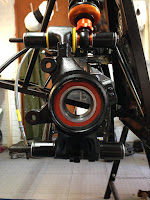 |
| Lovely, lovely, lovely |
After all that suspension bush malarkey, I thought it would be good to start to build up the rear suspension and make it look like I had actually done something. The biggest lesson learned during this stage: Never tighten anything up, because it will inevitably be coming off again... twice... if you're lucky.
I concentrated on the driver's side to begin with and the first stage was to attach the upper and lower wishbones to the chassis; a simple case of lining each one up to the existing mounts I hear you say, adding a washer either side and sliding a copper grease covered bolt through? Not really. Not every wishbone wanted to play ball and required quite a bit of force to fit. This was eventually achieved with an endless ratchet strap wrapped around the length of the chassis to provide some purchase.
 |
| It's in |
You may notice from the picture that this was done before I fitted the rear cabin panel, which was described in an earlier post (not everything written here is in completely chronological order!). This would've been much harder had the panel been in place as I looped the strap through the chassis. The bolts in this picture are also round the wrong way, as with the rear panel mounted, you would never be able to remove them.
The next stage was to get the coilover in place. Now, I was quite excitable at this stage, so I didn't give much thought to this initially and, as there weren't any instructions, I just grabbed one and bolted it on, brilliant. It did seem a little loose at the top for a precision item, so I hit the internet. It turns out that the top mount uses a 1/2" imperial bolt, rather than the initially more logical M12, this being a hangover from ye olde days of suspension and is kind of an historical standard. Bugger. I didn't have any 1/2" bolts. Once they arrived, I swapped it over with the M12 one I had bodged it with previously.
 |
| Damper adapters |
Now, each end of the damper has the same size hole through it, but uses different size bolts (1/2" at the top, M10 at the bottom), so mounting adapters are supplied. My initial thought was; if all the adapters are doing is compensating for different bolt sizes and fit into the same size hole, why are their external profiles different (see picture)? Nobody has yet been able to answer this question for me. The 10mm ones (on the left in each image) don't seem to hold the O-rings in place firmly like the 1/2" ones (on the right) do due to their greater taper and the 1/2" ones are physically taller when sat side-by-side. It doesn't matter too much, it just strikes me as odd.
 |
| Exciting! |
With the damper in place I could trial fit a hub, which was very exciting (it was, honest). If you looked at the picture on the right and thought that the top bolt through the hub looks way too long, have a star. A call to GBS soon had the correct length bolts in the post. Interestingly, a chat with a new member of GBS staff at the Stoneleigh kit car show later in the year about which parts of my kit seemed to be wrong or missing elicited an initial response of "let me guess, the rear hub bolts?" or words to that effect, so obviously, I'm not the only one who has had this issue.
After I had received the new bolts and refurbished my hubs (see earlier post) I could try and mount one properly for the first time. As with the earlier wishbone issues, this was not as easy as it should have been. Unfortunately, something is not right with my set-up somewhere, as bolting the hub straight though on the lower wishbone means that it won't sit where it should to line up with the top wishbone. I needed to use a lot of force to get the hub in at the top, which meant the whole system twisted up at the rear and made it very difficult to get the top bolt through.
 |
| Wonkey |
I tried taking everything apart and flipping the wishbones over, to see if I could gain anything, but they seem to be symmetrical, so that did nothing. I tried different combinations of washers, to try and shunt things along a bit, but again, it didn't work. Leaving it like this will wear the bushes very quickly, so I will need to find a solution before I go any further. Having looked around on the internet, it would appear that some other people are having the same issue, so there may be more to it than simple pilot error.
Part 2 coming soon...








































